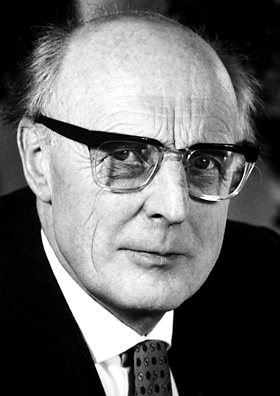
J. Hans D. Jensen (1907-1971)
On June 25, 1907, German nuclear physicist Johannes Hans Daniel Jensen was born. During World War 2, Jensen worked on the German nuclear energy project, known as the Uranium Club, in which he made contributions to the separation of uranium isotopes. Jensen shared half of the 1963 Nobel Prize in Physics with Maria Goeppert-Mayer for their proposal of the nuclear shell model.[8]
Hans Jensen – Early Years
Hans Jensen was born on 25 June 1907 as the third child of the gardener Karl Friedrich Jensen and his wife Helene Auguste Adolphine (née Ohm). From 1926 he studied physics, mathematics, physical chemistry and philosophy at the University of Hamburg and the Albert-Ludwigs-University in Freiburg im Breisgau. After receiving his doctorate in physics from Wilhelm Lenz, he remained in Hamburg as a scientific assistant and habilitated in 1936.
Chain Reaction and Nuclear Fission
Hans Jensen was appointed Privatdozent at the University of Hamburg in 1937. Back then, he also started working with Paul Harteck, the director of the university’s physical chemistry department and advisor to the Heereswaffenamt on explosives. In 1939, Harteck contacted the Reichskriegsministerium (Reich Ministry of War) in order to inform about potential military applications of nuclear chain reactions. Earlier that year, Otto Hahn and his assistant Fritz Strassmann sent a manuscript to the German science journal Naturwissenschaften reporting that they had detected and identified the element barium after bombarding uranium with neutrons. Before the article was published, Hahn sent the results and his conclusion of a bursting of the uranium nucleus in a letter to his colleague and friend Lise Meitner,[6] who had fled Germany in July to the Netherlands and then to Sweden. She and her nephew Otto Frisch confirmed Otto Hahn’s conclusion and interpreted the results as “nuclear fission”.[7]
The Uranium Club
A few days before Paul Harteck informed the ministry, Georg Joos and Wilhelm Hanle, notified Wilhelm Dames, at the Reichserziehungsministerium (Reich Ministry of Education), of potential military applications of nuclear energy. Soon, a group of physicists became informally known as the first Uranverein (Uranium Club). Next to Harteck, physicists including Hans Geiger, Wolfgang Gentner, Wilhelm Hanle, Gerhard Hoffmann, and Georg Joos were part of the project. Harteck also brought Hans Jensen in, who together developed a double centrifuge based on a rocking process to facilitate the separation effect. After the Uranverein was discontinued in August 1939, it continued its work the day World War II began. When the first meeting of the project took place, the invited included Walther Bothe, Siegfried Flügge, Hans Geiger, Otto Hahn, Paul Harteck, Gerhard Hoffmann, Josef Mattauch, and Georg Stetter. Later on Klaus Clusius, Robert Döpel, Werner Heisenberg, and Carl Friedrich von Weizsäcker also joined.
The German Nuclear Weapon Program
The point in 1942, when the army relinquished its control of the German nuclear weapon project, was the zenith of the project relative to the number of personnel devoted to the effort. There were only about seventy scientists working on the project, with about forty devoting more than half their time to nuclear fission research. After this, the number of scientists working on applied nuclear fission diminished dramatically. Many of the scientists not working with the main institutes stopped working on nuclear fission and devoted their efforts to more pressing war related work.
Post War Career and Nobel Prize
Hans Jensen became extraordinarius professor of theoretical physics at the Technische Hochschule Hannover in 1941. Five year later he was appointed ordinarius professor and later on he switched to the Ruprecht Karl University of Heidelberg. In 1950 he described giant resonances with Helmut Steinwedel using a two-fluid model of proton and neutron fluid. In 1955, together with his student Berthold Stech, he introduced chiral symmetry to the theory of weak interaction, a precursor of the later V-A theory of Richard Feynman and Murray Gell-Mann (1958). In 1963 Jensen shared half of the Nobel Prize in Physics with Maria Goeppert-Mayer for their proposal of the nuclear shell model. The remaining half of the prize was awarded to Eugene Wigner for unrelated work in nuclear and particle physics, especially through the application of fundamental symmetry principles.
Episode 4 – Three is a Magic Number (Eugene Wigner, Maria Goeppert Mayer, Johannes Jensen, 1963), [9]
References and Further Reading:
- [1] J. Hans D. Jensen at the Nobel Prize Foundation Website
- [2] J. Hans D. Jensen at Famous Scientists
- [3] J. Hans D. Jensen at Britannica Online
- [4] J. Hans D. Jensen at Wikidata
- [5] Otto Hahn – the Father of Nuclear Chemistry, SciHi Blog
- [6] Lise Meitner – The Misjudged Genius, SciHi Blog
- [7] Otto Frisch and the Nuclear Fission, SciHi Blog
- [8] Maria Goeppert Mayer and the Nuclear Shell Model, SciHi Blog
- [9] Episode 4 – Three is a Magic Number (Eugene Wigner, Maria Goeppert Mayer, Johannes Jensen, 1963), 66mm Wide @ youtube
- [10] Otto Haxel, J. Hans D. Jensen, and Hans E. Suess On the “Magic Numbers” in Nuclear Structure, Phys. Rev. Volume 75, 1766 – 1766 (1949). Institutional affiliations: Haxel: Max-Planck Institut für Physik, Göttingen; Jensen: Institut für theoretische Physik, Heidelberg; and Suess: Inst. für physikalische Chemie, Hamburg.
- [11] Hans-Arwed Weidenmüller: Jensen, Hans. In: Neue Deutsche Biographie (NDB). Band 10, Duncker & Humblot, Berlin 1974, ISBN 3-428-00191-5, S. 410
- [12] Timeline of Nobel Laureates in Physics, via Wikidata





